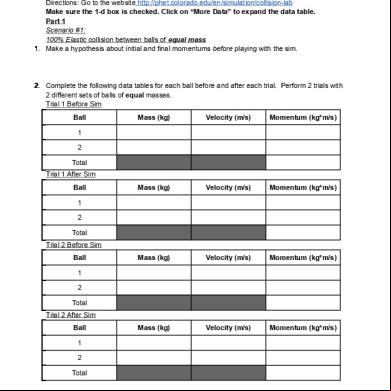Collision Lab- Conservation Of Momentum (newton’s 3rd Law) 2y3m38
This document was ed by and they confirmed that they have the permission to share it. If you are author or own the copyright of this book, please report to us by using this report form. Report 3i3n4
Overview 26281t
& View Collision Lab- Conservation Of Momentum (newton’s 3rd Law) as PDF for free.
More details 6y5l6z
- Words: 466
- Pages: 4
Collision Lab- Conservation of Momentum (Newton’s 3rd Law) Directions: Go to the website http://phet.colorado.edu/en/simulation/collision-lab Make sure the 1-d box is checked. Click on “More Data” to expand the data table. Part 1 Scenario #1: 100% Elastic collision between balls of equal mass 1. Make a hypothesis about initial and final momentums before playing with the sim.
2. Complete the following data tables for each ball before and after each trial. Perform 2 trials with 2 different sets of balls of equal masses. Trial 1 Before Sim Ball
Mass (kg)
Velocity (m/s)
Momentum (kg*m/s)
Mass (kg)
Velocity (m/s)
Momentum (kg*m/s)
Mass (kg)
Velocity (m/s)
Momentum (kg*m/s)
Mass (kg)
Velocity (m/s)
Momentum (kg*m/s)
1 2 Total Trial 1 After Sim Ball 1 2 Total Trial 2 Before Sim Ball 1 2 Total Trial 2 After Sim Ball 1 2 Total
Part 1 Scenario #2: 100% Elastic collision between balls of unequal mass 1. Make a hypothesis about initial and final momentums before playing with the sim.
2. Complete the following data tables for each ball before and after each trial. Perform 2 trials with 2 different sets of balls of unequal masses. Trial 1 Before Sim Ball Mass (kg) Velocity (m/s) Momentum (kg*m/s) 1 2 Total Trial 1 After Sim Ball Mass (kg) Velocity (m/s) Momentum (kg*m/s) 1 2 Total Trial 2 Before Sim Ball Mass (kg) Velocity (m/s) Momentum (kg*m/s) 1 2 Total Trial 2 After Sim Ball Mass (kg) Velocity (m/s) Momentum (kg*m/s) 1 2 Total 3. What is the relationship between the initial and final total momentums in Scenario 1? In Scenario 2?
4. Describe the motion of the balls before and after the collision in Scenario 1. Describe the motion of the balls before and after the collision in Scenario 2.
Part 2 Create 3 more distinct scenarios in 1-d including one totally inelastic collision (0% elasticity). For each scenario, list the elasticity percentage, fill out the data tables, and make a hypothesis whether or not each will follow conservation of momentum. Collect some data and prove or disprove your hypothesis. Scenario #1 Elasticity %: Hypothesis:
Before Sim Ball Mass (kg) 1 2 Total After Sim Ball Mass (kg) 1 2 Total Hypothesis accepted or rejected?
Velocity (m/s)
Momentum (kg*m/s)
Velocity (m/s)
Momentum (kg*m/s)
Velocity (m/s)
Momentum (kg*m/s)
Velocity (m/s)
Momentum (kg*m/s)
Scenario #2 Elasticity %: Hypothesis:
Before Sim Ball Mass (kg) 1 2 Total After Sim Ball Mass (kg) 1 2 Total Hypothesis accepted or rejected? Scenario #3
Elasticity %: Hypothesis:
Before Sim Ball Mass (kg) 1 2 Total After Sim Ball Mass (kg) 1 2 Total Hypothesis accepted or rejected?
Velocity (m/s)
Momentum (kg*m/s)
Velocity (m/s)
Momentum (kg*m/s)
Summary In a minimum of 3 sentences, describe the main ideas learned in this activity regarding initial and final total momentum in these collisions.
2. Complete the following data tables for each ball before and after each trial. Perform 2 trials with 2 different sets of balls of equal masses. Trial 1 Before Sim Ball
Mass (kg)
Velocity (m/s)
Momentum (kg*m/s)
Mass (kg)
Velocity (m/s)
Momentum (kg*m/s)
Mass (kg)
Velocity (m/s)
Momentum (kg*m/s)
Mass (kg)
Velocity (m/s)
Momentum (kg*m/s)
1 2 Total Trial 1 After Sim Ball 1 2 Total Trial 2 Before Sim Ball 1 2 Total Trial 2 After Sim Ball 1 2 Total
Part 1 Scenario #2: 100% Elastic collision between balls of unequal mass 1. Make a hypothesis about initial and final momentums before playing with the sim.
2. Complete the following data tables for each ball before and after each trial. Perform 2 trials with 2 different sets of balls of unequal masses. Trial 1 Before Sim Ball Mass (kg) Velocity (m/s) Momentum (kg*m/s) 1 2 Total Trial 1 After Sim Ball Mass (kg) Velocity (m/s) Momentum (kg*m/s) 1 2 Total Trial 2 Before Sim Ball Mass (kg) Velocity (m/s) Momentum (kg*m/s) 1 2 Total Trial 2 After Sim Ball Mass (kg) Velocity (m/s) Momentum (kg*m/s) 1 2 Total 3. What is the relationship between the initial and final total momentums in Scenario 1? In Scenario 2?
4. Describe the motion of the balls before and after the collision in Scenario 1. Describe the motion of the balls before and after the collision in Scenario 2.
Part 2 Create 3 more distinct scenarios in 1-d including one totally inelastic collision (0% elasticity). For each scenario, list the elasticity percentage, fill out the data tables, and make a hypothesis whether or not each will follow conservation of momentum. Collect some data and prove or disprove your hypothesis. Scenario #1 Elasticity %: Hypothesis:
Before Sim Ball Mass (kg) 1 2 Total After Sim Ball Mass (kg) 1 2 Total Hypothesis accepted or rejected?
Velocity (m/s)
Momentum (kg*m/s)
Velocity (m/s)
Momentum (kg*m/s)
Velocity (m/s)
Momentum (kg*m/s)
Velocity (m/s)
Momentum (kg*m/s)
Scenario #2 Elasticity %: Hypothesis:
Before Sim Ball Mass (kg) 1 2 Total After Sim Ball Mass (kg) 1 2 Total Hypothesis accepted or rejected? Scenario #3
Elasticity %: Hypothesis:
Before Sim Ball Mass (kg) 1 2 Total After Sim Ball Mass (kg) 1 2 Total Hypothesis accepted or rejected?
Velocity (m/s)
Momentum (kg*m/s)
Velocity (m/s)
Momentum (kg*m/s)
Summary In a minimum of 3 sentences, describe the main ideas learned in this activity regarding initial and final total momentum in these collisions.











